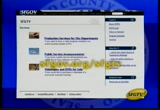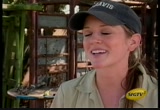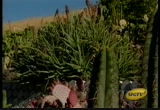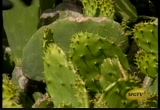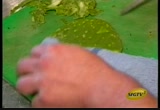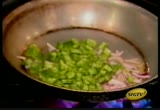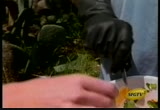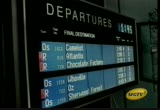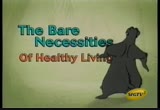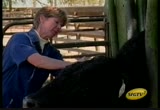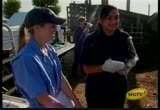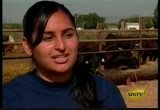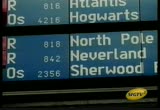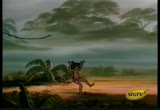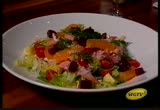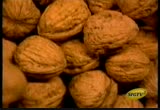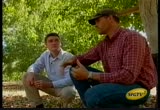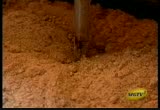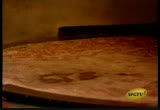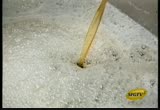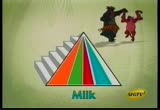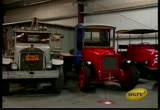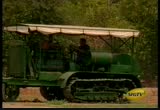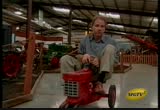tv [untitled] September 7, 2010 4:30pm-5:00pm PST
5:31 pm
dweller that's wowing chefs. >> that's good. >> then it's time to get a little nutty. >> well, with the walnut oil, it's a very full-flavored oil, very nutty and robust. >> and find out why these kids may play an important part in the future of agriculture in california. >> i'm kind of a girly girl. some days i wake up, i'm like, "gosh. i do not want to get dirty today." >> it's all ahead, and it starts now. one of the great things about farming in california is that it seems like almost anything can grow here. and just when you think you've seen everything, a farm like this comes around. welcome to rivenrock gardens, just outside of nipomo. farmer john dicus came up
5:32 pm
with the idea, and the rest, as they say, is history. >> it's really healthy. it's an environmentally friendly type plant. it doesn't require quite as much water, nutrients as anot@er plant would for the same amount of food value that you get from it. it's a healthy plant. we eat it for ourselves just for the health that it gives. so it seemed to be a natural plant to share. >> though they may look the same to us, there are actually about 400 varieties of cacti, and while not all are edible, john does grow an edible variety called nopalea grande. during peak season, he is shipping upwards of 3,000 pounds of the plant at a time, and while some go to pet-food stores for tortoises to enjoy, most of the plants here are used for human consumption. so john has a grading system he uses when harvesting. >> we have several different grades, depending on what the consumer wants. this is grade-a, tender, beautiful, exquisite, baby-vegetable cactus,
5:33 pm
shipped with ultimate care in packing. this would be grade-b, also for the gourmand, but a little larger. not as much packing material in there to protect it. this is a good grace-c, very good for the ultimate consumer, easy to prepare and clean. you've got a lot of food value per leaf. >> grown on hillsides with plenty of sun and well-drained soil, the plants love to grow close together, and from planting to harvest, it can take months even years tc get full growth out of the plants. as you might expect with the prickly plants, harvest is a unique one, involving two key ingredients for success--a sharp knife and sgme heavy-duty gloves. and from grading to harvesting to packing, john does it all here, so he doesn't mind a little help every once in a while.
5:34 pm
>> so, what does it take to harvest cactus? what are we looking for here? >> well, i like them to be about the size of your hand, maybe a little bit larger, as long as they're not overmature and pithy inside. these are all nice and fresh and young. >> that looks small, though. too small? >> they're a little small. this is good for grade-b perhaps. >> oh, that's a big one. wow. >> that's a beautiful grade-c. >> grade-c, huh? >> yes. because it's so large. >> oh. >> but it's in great condition. that will actually make a perfect cactus salsa for us. >> i like what you're thinking. >> john's main business comes from shipping across the country to customers who consider cacti an exotic
5:35 pm
delicacy of sorts. but while they may seem exotic to us, they remain very popular south of the border. in mexico, cacti are a $150 million business, which is why chef arnulfo hernandez has incorporated them into this authentic mexican cuisine at reposado in palo alto. hang grown up in mexico, he relied on his mother's cacti recipes to highlight the unique veggie with an even more unique taste. >> tangy...earthy... and pleasant flavor. but you've got to get used to it, to the texture more than anything. the texture is the most challenging thing in the cactus. but if you execute it like the way i do it, you will not have a problem. if you can, salt it prior to order, because if you add salt to it, it releases all of the stuff that it's inside of the flesh, the liquid, and you don't
5:36 pm
want that. so just prior to serve, season it with salt. the best way to play witthis is just, you know, let them boil for a few minutes. once they get dark, they're pretty much ready. and then you have to very much cool them off before you roast them or grill them. >> with a soft but crunchy texture that also becomes a bit sticky when cooked, kind of like okra, edible cactus tastes similar to a slightly tart green bean or even green pepper. chef hernandez recommends grilling them so the leaves stay crisp and not soggy. and he uses them in a variety of ways, from a salad to a sauce to a cacti sorbet which, along with a shot of tequila, is actually used as an after-dinner palate cleanser in the cuisine. who knew? but if you want to try your luck at home with cactus and want a super-easy, super-simple recipe, look no further than
5:37 pm
farmer john's salsa recipe. >> and so, this looks good, but the secret ingredient is? >> cactus. >> ok. let's put that in there. >> the whole batch. >> so that just kind of adds a little texture to it, huh? >> and also the mucilage in the cactus will help bind everything together. a couple hours in the refrigerator blends all the flavors. >> ooh, nice. >> and it's very healthy. >> i was going to take a chip. >> dip on in. >> enjoy it with me, right? a little cactus. that's good. >> mm-hmm. >> that's the way to end the day. yeah, that's good. for "california country," i'm tracy sellers. >> brought to you by allied insurance, a member of the nationwide family of companies, which also includes nationwide insurance. on your side.
5:38 pm
>> the people, the places, the unforgettable tastes of california will be back in a moment. >> as californians, we're connected to agriculture. that's why the allied insurance partnership with the california farm bureau offers us discounts on auto insurance, whether we live on the farm or in the city. as a member of the nationwide family of companies, allied insurance is committed to protecting what's important, for you and your community. contact your local agent today. >> ♪ nationwide is on your side ♪
5:39 pm
>> want to visit the central coast? well, there's no better time than this fall. that's because "sunset" magazine and santa margarita ranch are hosting the "savor the central coast" event, which will celebrate the bounty and the beauty of this area in an incredible 4-day experience. "sunset" editors, celebrity chefs, and artisan food makers will all be there to highlight some of the region's best-kept secrets. it happens this fall, and you won't want to miss out. for tickets, go to savorcentralcoast.com, and we'll see you there.
5:40 pm
>> welcome back to "california country." >> for dozens of kids, the main attraction at this year's california state fair was not a ride, but a chance to put gn some surgical gowns and gloves and pretend to be a vet. >> i just learned about blood, and now i'm going to learn about the heart, and then after this station, i believe, the eyeball. >> for a couple of hours, about a hundred kids, some peering into microscopes, were transformed into animal surgeons, and they were giving the kids vet school workshops the thumbs-up. >> well, i want to be a veterinarian or just maybe a doctor or a police officer like my dad. >> although a lot of young children are interested in learning about animals at this stage, research shows only a handful of them will actually grow up and choose a career working with cattle or other large animals. >> well, large-animal vets
5:41 pm
provide a variety of important functions in california. not only are they practicing veterinarians to take care of the animals on the farms, which is the firpt step in the food supply. so it's critical that those animals are healthy. >> since california has the largest agricultural economy in the u.s. and about 14,000 beef cattle operations, the lack of livestock veterinarians is alarming. now meet 24-year-old zuhal elhan and ashley amaral, who are bucking the trend. they're students at u.c. davis school of veterinary medicine, interning with dr. nancy martin, who is an experienced vet and is giving them hands-on training working with bulls on a yolo county family ranch. >> it's really amazing, because you can only learn so much in a classroom. the classroom gives us a great basis, and then coming out during the summer, it just gives us the clinical experience that helps tie all t ideas we get from the classroom togethep.
5:42 pm
>> today they're learning to test the bulls for disease. it sounds simple, but it's not, especially as some of these bulls can weigh 1,300 pounds. >> yeah. no, the first time that i had to measure the... you know, something under the bull, and every time he moved, i jerked back, pulled away, because i don't want to get kicked. but i think that having that awareness and that respect for the animal is what prevents me from getting hurt. >> ok, zuhal. 89-79. >> despite their busy day, there's always time for fun. and it's usually muddy fun. this testing program is important for cattle ranchers like kim and hry favier. they're fourth-generation ranchers who own the bulls on this family ranch. >> it means a lot to us. it's part of the land. we're part of an industry that i'm very proud of. and it's a lifestyle. it's a lot of hard work, but it's a great way to live. >> they tell me each bull can produce about 50 calves, and since a calf can sell for about $500, an infertile bull in a commercial herd cab be
5:43 pm
economically devastating. >> if a bull can't breed a cow, the cow doesn't have a calf. if we don't have a calf, we don't have a product. >> that's why they're pleased to see veterinarians like dr. martin mentoring and teaching the next generation of vets like ashley and zuhal. >> today it's very difficult to get young people to want to come into this career in agriculture. so it's very important that we have young people that come out with dr. martin or other veterinarians to help teach them and bring them into this industry. >> dr. martin spends hours mentoring the students, sometimes working on different ranches a day. by the end of it all, everyone is dirty and tired but pleased. >> 'm kind of a girly girl. some days i wake up, i'm like, "gosh, i do not want to get dirty today." and by the end of the day, i'm usually covered in something not so pleasant. so, it's always nice to go home and take a good shower afterwards. >> students on the u.c. davis program typically spend
5:44 pm
much of their 2-year course on a commercial cattle operation like this ranch. working alongside vets and attending daily calls are an important part of it. zuhal, who grew up in urban los angeles, admits that working with cattle is the last thing she ever thought of doing as a child. but now she's tried u.c. davis early veterinary student bovine experience program, she is hooked. >> it's different, and it's one of those things that, until you get exposed to it, you can't really appreciate it. and we're so closed off from the food-animal industry in suburbia or in an urban environment. you don't see the ranches. you don't know how much work goes into it. you get your hamburger nicely packaged, and so it's all of us out here that make that meat come to you and be healthy and safe. >> now she hopes more young people qill join her and choose a career working with california cattle on a farm. charlotte fadipe for "california country" tv.
5:45 pm
>> this segment is brought to you by the california farm bureau federation. >> our dad used to say, "when you work hard for something, protect it." >> that's why he got nationwide insurance more than 30 years ago. >> we're still with them today, because no matter what changes in our lives, whether it's starting a business or building a house. >> having kids or buying a car. >> with an "on your side" review from nationwide insurance, we get the coverage we need at the right price for us. >> ♪ nationwide is on your side ♪ >> make sure your coverage keeps up with your life. ask your local agent or call 877-306-1252 today. >> it's one thing to buy things in boxes and packages and just have it show up. it's another thing to actually
5:46 pm
know where that is produced and where it's come from and how it's produced. i think it even goes further when you have some kind of personal connection to it. >> literally farm to table. literally it's like from the gardens, from the dirt. i mean, they cme straight from that place. the connection--when you make that connection with a farmer, with growers, it makes for a different feeling when you're cooking. for me now, things taste different. >> welcome back to "california country."
5:47 pm
>> califorans are used to being called a little nutty. but now it could be considered more of a compliment, thanks to the fact that the golden state accounts for nearly 99% of the u.s. supply of walnuts and nearly 2/3 of the world's supply. this versatile little nut can be enjoyed in savory and sweet foods and can even be a critical link to having a healthy diet, all of which has made this california treat a lot of new fans. and it's because of that newfound popularity that more and more companies are turning to walnuts for their new products, including this one in the central valley, where they're turning all of these walnuts into liquid gold. here in california on land from redding to bakersfield, more than 200,000 acres are devoted to walnut production. dan martinez and his family have been rooted in the walnut industry since the fifties. they call the fertile soil of winters home base and say
5:48 pm
it is the absolute perfect place to grow one of nature's perfect foods. >> in particular in winters, we have, i think, an ideal climate for walnuts in addition to the climate, we have great deep soil along putah creek on the south side, deep, very alluvial soil, and access to a lot of and good, clean water. >> today, dan and his family grow 700 acres of grapes and rootstock in addition to the 170 acres of walnuts they have. but to stay competitive in the nut world, they've been looking for other venues to sell their walnuts. one of them came just down the road in woodland at the la tourangelle nut oil company. >> it's been great, a very dynamic business. we're always looking for people like ourselves who are dynamic and trying new things in the industry. so this is one great outlet for us to have the walnut oil for a place to... part of our crop anyway.
5:49 pm
>> taking the best of both worlds--fresh california walnuts and french production methods-- frenchman matthieu kohlmeyer has created this aountry's first homegrown nut oil. each batch is unique and hand-crafted, following a 150-year tradition that matthieu followed in france. but when it came time to open up shop here in the states, there was no question on where to go. >> well, you know$ winters is-- you know, we're surrounded by walnut trees, so it made nse really to come here. you know, people really like walnuts. they know them very well. so we...we're in the perfect area to grow. and i mean, you know, it's california. it's nice weather. i think i choose a very nice place. before matthieu's invention, nut oils were strictly imports and thus lacked taste and affordability for most consumers. mattheiu says the keys to a superior nut oil are twofold. first, the method is crucial,
5:50 pm
which involves taking the walnuts from dan's farm and sun-drying them, shelling, grinding, and then roasting the nuts, all to enhance flavor. and the other secret to success? the walnuts, of course. >> well, it's simple. i mean, what we're doing is not only extracting the oil from the walnut, what we are trying to get is the flavor of the walnut in the oil, and that's really what makes the difference in the quality. so what we do is by roasting the nuts, you get the flavor really strong, and so the best walnuts you use, the best walnut oil you'll get. so dan, you know, using these really nice natural walnuts, is getting really... the flavor is great. well, i think until now, until we arrived here, they could only find that imported from france. so it was expensive. often it was a little rancid, too, because it was so-- you know, the time between the production time and, you know, it arrived here. so, you know, the fact that it's very fre, local, makes them, you know, even more excited. and to be local is important, too.
5:51 pm
you know, i think there's a strong trend today to rediscover, you know, what we have in our backyard. no need to go 5,000 miles away. so... >> mmm. yeah. really good flavor. that's going to be a great product. so every batch is going to be different. >> the popularity of the walnut oil has increased in recent years thanks to the good news about heart-healthy omega-3 fatty acids in walnut oil, something our ancestors knew back in the day. during medieval times, walnuts were actually considered a medicine used to treat everything from muscle aches to digestive problems. la tourangelle now produces 14 different types of oils, from almond to sesame to pumpkin to avocado oil. but the biggest seller is the walnut oil. more than 15,000 tins are sold every month to retail outlets nationwide and have found a following with chefs looking for
5:52 pm
a new flavor enhancer. >> well, with the walnut oil, it's a very full-flavored oil, very nutty and robust. typically you would want to use that as either a finishing oil or in a vinaigrette. >> at roseville's newest and ttest restaurant, paul martin's bistro, chef joskorn says the oil adds a nice nutty pop to whatever he's working with, whether it's veggies, salads, or even main dishes. but more than that, the new product is a way to support their local farming community. >> well, that's a way of life for these people, you know. they live out on that farm. they get up before the sun. they get out there and roll up the sleeves and get dirty, and you know, that's their life. so that's why we're so big on supporting those people. that's their livelihood, and anything that we can do to help support them and keep agricultural land agricultural land for growing, you know, we're all about that. whatever we can do to help. >> this trio is proving you can celebrate e flavors of theeason in a variety of ways, all thanks to one little nut and one big idea. for "california country,"
5:53 pm
i'm tracy sellers. >> as californians, we're connected to agriculture. that's why the allied insurance partnership with the california farm bureau offers us discounts on auto insurance, whether we live on the farm or in the city. as a member of the nationwide family of companies, allied insurance is committed to protecting what's important for you and your community. contact your local agent today. >> ♪ nationwide is on your side ♪ >> this is a bluebird box, and it's a very small little bird that needs a box to nest in.
5:54 pm
5:55 pm
>> woodland, california, has a history as one of the largest and most important agricultural centers in the northern part of the state. and there's a place on the edge of town that reflects much of that htory. in two huge bui@dings near interstate 5, you'll find the fred c. heidrick antique ag collection, the world's largest and most unique collection of one-of-a-kind antique agricultural equipment, and the hays antique truck museum, also recognized as the largest of its kind in the world. but this is much more than old trucks and farm implements. at the center, much history is shared through interactive exhibits, entertaining events, and stories told by people like lonnie wunder. >> fred heidrick was a major farmer in the area. he farmed over 30,000 acres at one time. and he ended up collecting farm equipment all of his life. >> and quite honestly, when you get to be a successful farmer, you can go out, and you can talk to other guys, and most of these guys like to talk about the old days. and so he'd look over there, and he'd say, "ok, joe,
5:56 pm
"what are you going to do with that old cat over there?" and so he would talk him out of it and bring it home and restore it. >> our docents aren't trained to tell stories. our docents are trained to listen to other people's stories and then tell those stories again. >> farming is backbreaking labor. and so they invented something that would help them. and on a farm, usually in the summertime you're busy. and in the wintertime, th'd go to town, they'd sit around the blacksmith's shop, and they'd talk about, "let's invent this to make it easier." >> i think it's time we fire one of these up and go for a ride. >> oh, we've got an interesting crew over here. it's called the tuesday crew.
5:57 pm
there's a bunch of old boys over there. some of them are former navy mechanics. some of them are fcrmer farm mechanics. some of them had never seen a tractor before in their life or a truci. but then they go out, and they start taking off rusty bolts, and they rebuild some of that old stuff, and then the proudest moment is when they can crank it up, and they drive it out of the shop. >> here's an early version of a bucket seat. rich corinthian leather. and this one-- standing room only. >> this harris harvester from stockton, california, was built in 1920. it cuts, it thrashes, and it bags the grain. all of these things are combined in one machine, and that's why we have the name "combine." any old boy that couldn't afford both could have the truck. he could w@rk on it in the daytime with the tractor wheel, come in at night,
5:58 pm
take the wheels off, put on the rubber-tired truck wheels, and go to town. >> the 5,000-plus visitors a month we get into this museum comes from all over the world-- denmark, germany, france. so we get more people coming from outside the country than we do from california usually, to have a love of the tractors and of the history. >> the heidrick ag center, just off highway 5 and road 102. bring the whole family. there's a gift shop, there's a lot of great equipment, a ton of collections, and the kids even get to drive these around while they're seeing the exhibits. it's fun for everybody. >> well, that is going to do it for the show today. if you have any questions about anything you've seen, check out our website at californiacountry.org. and we'll see you again next week on "california country."
107 Views
IN COLLECTIONS
SFGTV2: San Francisco Government Television Television Archive
Television Archive  Television Archive News Search Service
Television Archive News Search Service 
Uploaded by TV Archive on

 Live Music Archive
Live Music Archive Librivox Free Audio
Librivox Free Audio Metropolitan Museum
Metropolitan Museum Cleveland Museum of Art
Cleveland Museum of Art Internet Arcade
Internet Arcade Console Living Room
Console Living Room Books to Borrow
Books to Borrow Open Library
Open Library TV News
TV News Understanding 9/11
Understanding 9/11